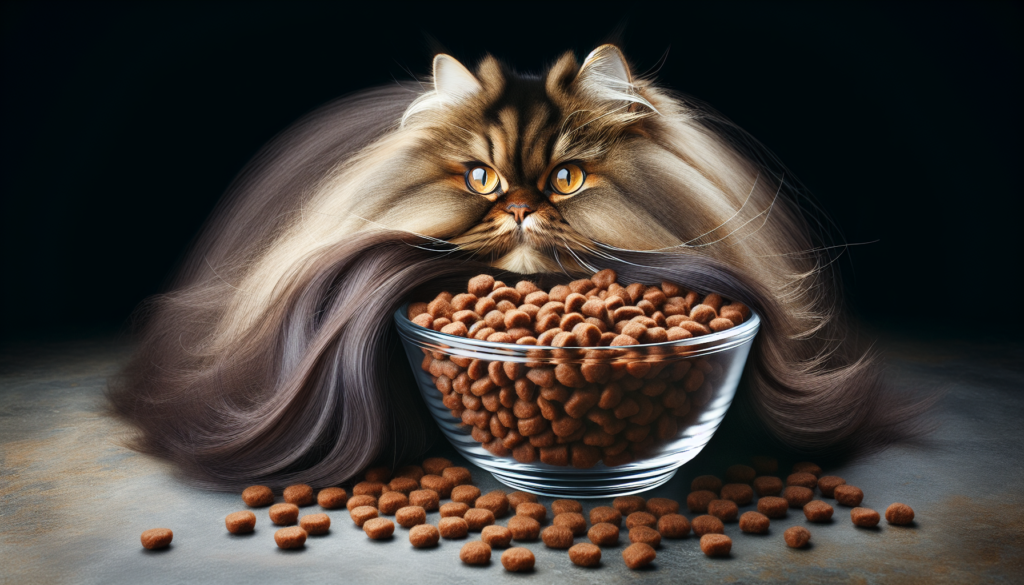If you’re a proud owner of a Persian cat, you already know that they are quite unique in their dietary needs. With their luxurious coats and distinctive physical features, it’s important to provide them with the right amount of nourishment to keep them healthy and happy. In this article, we’ll provide you with tips on how to effectively feed your Persian cat, ensuring they receive the appropriate portions and nutrients they require. From understanding portion sizes to selecting the right type of food, these tips will help you navigate the world of feeding a Persian cat with ease. So, let’s dive in and ensure your feline friend stays well-fed and content!

Feeding Requirements for Persian Cats
Understanding the Nutritional Needs
Feeding your Persian cat is a crucial aspect of caring for their overall health and well-being. It’s important to understand their specific nutritional needs in order to provide them with a balanced and appropriate diet. Persian cats require a diet that is rich in essential nutrients such as protein, fat, and carbohydrates. Additionally, they need specific vitamins and minerals to support their coat health, prevent urinary issues, and maintain their overall vitality.
To ensure that you are meeting your Persian cat’s nutritional needs, it is highly recommended to consult a veterinarian. A veterinarian can assess your cat’s individual requirements and provide tailored advice on the appropriate diet and feeding plan. They are knowledgeable about the specific dietary needs of Persian cats and can guide you in choosing the best food options for your feline friend.
Determining the Right Portion Size
After consulting with your veterinarian and selecting the right cat food for your Persian, it’s important to determine the appropriate portion size for each meal. Portion sizes depend on various factors such as your cat’s age, weight, activity level, and metabolism. To avoid overfeeding or underfeeding, it is recommended to follow the feeding guidelines provided by the cat food manufacturer and adjust portions based on your cat’s individual needs.
Choosing the Right Cat Food
Age and Life Stage Considerations
When choosing cat food for your Persian, it is essential to take into account their age and life stage. Kittens have different nutritional requirements compared to adult and senior cats. It is crucial to select a cat food that is specifically formulated to meet the needs of your Persian cat’s age group.
Preference for Wet or Dry Food
Persian cats often have a preference for wet or dry food. It is important to consider their preference while also keeping their health in mind. Wet food provides higher moisture content, which can be beneficial for Persian cats who may not drink enough water. Dry food, on the other hand, can help maintain dental health by helping to remove plaque buildup.
Quality Ingredients without Fillers
It is vital to choose cat food that contains high-quality ingredients and avoids fillers. Look for cat foods that have whole meat or fish as the main ingredient, as this provides the necessary protein for your Persian cat. Avoid cat foods that contain artificial preservatives, colors, or flavors, as these can have negative effects on your cat’s health. Read the labels carefully and opt for brands that prioritize quality and nutrition.
Feeding Frequency and Schedule
Ideal Number of Daily Meals
Persian cats generally benefit from having multiple small meals throughout the day rather than a single large meal. This helps prevent overeating and promotes healthy digestion. It is recommended to feed your Persian cat at least three to four small meals a day. This will help satisfy their natural grazing behavior and keep their energy levels stable.
Establishing a Feeding Routine
Consistency is key when it comes to feeding your Persian cat. Establishing a feeding routine can help regulate their digestive system and create a sense of security for your feline companion. Choose specific times of the day to feed your cat and try to stick to this schedule as closely as possible. Creating a routine will not only ensure that your cat receives regular meals but also allows you to monitor their appetite and overall health more effectively.
Avoiding Free Feeding
Although it may be tempting to leave food out all day for your Persian cat to graze on, free feeding is not recommended. Free feeding can lead to overeating, obesity, and various health issues. It is important to control your cat’s portion sizes and meal frequency to maintain their weight and overall well-being. By providing measured meals at specific times, you can ensure that your Persian cat receives the appropriate amount of food each day.
Transitioning to a New Diet
Gradual Switching Process
If you need to transition your Persian cat to a new diet, it is important to do so gradually. Sudden changes in their diet can cause digestive upset and reluctance to eat. Start by mixing a small amount of the new food with their current food. Gradually increase the proportion of the new food over a period of one to two weeks until your cat is fully transitioned to the new diet. This gradual process allows their digestive system to adapt to the new food without any discomfort.
Monitoring for Digestive Upset
During the transition period, it is essential to monitor your Persian cat for any signs of digestive upset. Common signs include vomiting, diarrhea, or a decrease in appetite. If you notice any of these symptoms, slow down the transition process or consult your veterinarian for further guidance. Each cat is unique, and some may require a slower transition to a new diet.
Patience during the Transition
Switching your Persian cat’s diet can be a gradual process that requires patience. It is important to remain patient and understanding throughout the transition period. Encourage your cat to eat the new food by offering small portions at regular intervals. If they seem hesitant or reluctant, try adding some warm water to moisten the food or gently warming it to enhance its aroma. Remember, a smooth transition is beneficial for your Persian cat’s digestive health and overall well-being.

Water Availability and Hydration
Clean and Fresh Water at all Times
Alongside a balanced diet, providing clean and fresh water is vital for your Persian cat’s hydration. Cats generally have a low thirst drive, so it is crucial to encourage regular water intake. Ensure that fresh water is available to your cat at all times, and regularly clean and refill their water bowl to keep it fresh and appealing.
Encouraging Water Intake
Persian cats may require extra encouragement to drink an adequate amount of water. Some cats prefer running water, so providing a water fountain can be a great option. Another way to encourage water intake is by placing multiple water bowls around your home, ensuring that they are easily accessible to your cat. Experimenting with different types of bowls, such as shallow or wide bowls, can also help encourage your cat to drink more.
Supplementing with Moist Foods
To increase your Persian cat’s water intake, you can consider supplementing their diet with moist foods. Wet cat food contains a higher moisture content compared to dry food, which helps keep your cat hydrated. Introducing small portions of wet food alongside their regular diet can provide additional hydration and support their overall health.
Avoiding Harmful Foods
Toxic Foods for Cats
When it comes to feeding your Persian cat, it is crucial to be aware of foods that are toxic to cats. Some common foods that can be harmful include chocolate, onions, garlic, grapes, raisins, and certain types of nuts. These foods can cause serious health issues, ranging from gastrointestinal upset to kidney failure. Always double-check the ingredients of any human food before sharing it with your Persian cat, and if in doubt, consult your veterinarian.
Common Allergens
Just like humans, cats can have food allergies or sensitivities. Common allergens for cats include dairy products, grains, certain types of meat, and fish. If you suspect that your Persian cat may have a food allergy or sensitivity, consult your veterinarian for advice. They can conduct tests or recommend an elimination diet to identify the specific allergen and provide suitable alternative food options.
Foods with Excessive Seasonings
It’s important to avoid feeding your Persian cat foods that are heavily seasoned or contain excessive spices. Cats have more sensitive taste buds compared to humans, and certain seasonings or spices can be irritating or harmful to them. Additionally, some spices, such as garlic and onion powder, can be toxic to cats. Stick to plain, unseasoned foods that are safe and appropriate for your Persian cat’s dietary needs.
Feeding Accessories and Tools
Choosing the Right Food Bowl
When selecting a food bowl for your Persian cat, opt for materials that are easy to clean and don’t retain odors or bacteria. Stainless steel or ceramic bowls are excellent choices. Avoid plastic bowls as they can harbor bacteria and may cause allergic reactions in some cats. Make sure the bowl is wide enough to accommodate your cat’s muzzle comfortably.
Consideration for Elevated Bowls
Due to their distinct facial structure, Persian cats may benefit from elevated food bowls. Elevated bowls can minimize neck strain and facilitate more comfortable eating and swallowing. This is especially important for cats with flat faces or breathing difficulties. Consider using raised or elevated food bowls specifically designed for cats to provide them with an optimal feeding experience.
Food Mat or Placemat
Using a food mat or placemat underneath your Persian cat’s food and water bowls not only helps protect your floors from spills and messes but also makes cleanup easier. Choose a mat that is waterproof and easy to wipe clean. This simple addition can keep your feeding area neat and hygienic, providing a pleasant dining experience for your Persian cat.
Monitoring the Cat’s Weight
Importance of Regular Weigh-ins
Maintaining a healthy weight is crucial for the overall well-being of your Persian cat. Regular weigh-ins can help you monitor your cat’s weight and detect any gradual changes. Obesity is a common issue in Persian cats, so it’s important to keep an eye on their weight and consult your veterinarian if you notice any significant fluctuations.
Obesity Prevention
To prevent obesity in your Persian cat, it’s important to feed them a balanced diet and provide them with regular exercise. Measure their food portions accurately and avoid overindulging them with treats or table scraps. Engage them in interactive play sessions to keep them active and help them burn calories. By maintaining a healthy weight, you can help prevent numerous health issues and ensure a longer, happier life for your feline companion.
Consulting the Veterinarian for Weight Management
If you are concerned about your Persian cat’s weight or have difficulty managing their weight, it is recommended to consult your veterinarian. They can assess your cat’s body condition score and provide expert advice on weight management techniques. Your veterinarian may recommend adjusting the portion sizes, changing to a weight management cat food, or creating an exercise plan tailored to your cat’s individual needs.
Maintaining Dental Health
Incorporating Dental Treats
Proper dental care is essential for your Persian cat’s overall health. Incorporating dental treats into their routine can help promote dental hygiene and prevent dental disease. Look for dental treats that are specifically designed for cats and have a texture that helps clean their teeth as they chew. Regular use of dental treats can help reduce tartar buildup and keep your Persian cat’s teeth clean and healthy.
Brushing the Cat’s Teeth
Brushing your Persian cat’s teeth is an effective way to maintain their dental health. Start by introducing tooth brushing gradually, using a cat-specific toothbrush and toothpaste. Begin by gently rubbing their gums and teeth with your finger, and gradually progress to using a toothbrush. Establishing a tooth brushing routine can help prevent dental issues such as gum disease and tooth decay.
Professional Dental Cleaning
Regular professional dental cleanings are necessary to ensure your Persian cat’s dental health. While at-home dental care is beneficial, it may not be sufficient to remove all plaque and tartar buildup. Schedule regular dental cleanings with your veterinarian, who can thoroughly examine your cat’s teeth and gums and perform a professional cleaning if necessary. Professional dental cleanings under anesthesia provide a comprehensive and safe approach to maintaining your Persian cat’s dental health.
Exercise and Mealtime
Using Interactive Feeders
Incorporating exercise into your Persian cat’s mealtime routine is a fantastic way to keep them mentally and physically stimulated. One way to achieve this is by using interactive feeders or puzzle toys. These specialized toys require your cat to work for their food, engaging their natural hunting instincts and providing mental stimulation. By combining mealtime with playtime, you can keep your Persian cat entertained and promote a healthy lifestyle.
Combining Playtime with Meals
Regular play sessions are crucial for your Persian cat’s overall well-being. Engage in interactive play with your cat using toys such as wand toys, laser pointers, or balls. You can also make playtime more exciting by incorporating food puzzles or treat-dispensing toys. Utilizing these toys during playtime allows your Persian cat to be mentally engaged and rewarded while getting exercise.
Outdoor vs. Indoor Activities
When it comes to exercise, it’s important to consider the safety of your Persian cat. If you choose to allow your cat to explore the outdoors, ensure that they have a safe and secure environment, away from busy roads or potential hazards. Supervised outdoor activities such as leash walking or providing them with a secure outdoor enclosure can be great options to allow your cat to get fresh air and exercise while minimizing risks. If you prefer to keep your Persian cat indoors, provide them with plenty of toys and playtime opportunities to keep them active and entertained.
In conclusion, understanding the feeding requirements for your Persian cat is crucial for their overall health and well-being. By considering their nutritional needs, choosing the right cat food, establishing a feeding routine, and providing necessary accessories, you can ensure that your Persian cat receives the proper nutrition and care they deserve. Regular monitoring, maintaining proper hydration, avoiding harmful foods, and incorporating dental health practices will contribute to their long-term health. Combined with exercise and mental stimulation, you can create a balanced and fulfilling lifestyle for your Persian cat. Remember to consult your veterinarian for personalized advice and guidance to meet the unique needs of your feline companion.

